How to prepare and paint the walls, what paint to choose?
When the question arises of what kind of decoration to choose for the walls, then many of us choose between wallpaper and painting - it is these two coatings that remain leaders for many years and are not going to take their positions. What are the advantages of painting walls, which paint is better to choose and how to apply it correctly - you can find answers to all these questions below.
Advantages and disadvantages of painting walls
Let's start with the benefits:
 it immediately comes to mind that with the help of paint you can realize any dream of creating a certain color, since there are many options on the market, and all this is complemented by the ability to create shades of your choice;
it immediately comes to mind that with the help of paint you can realize any dream of creating a certain color, since there are many options on the market, and all this is complemented by the ability to create shades of your choice;- with proper surface preparation, the finished coating will remain intact and safe for a long time without cracking;
- it is easy to remove stains and stains from a painted surface, most can be washed thoroughly without fear of damage;
- paint will certainly not be interesting to pets, therefore, there will be no scratches, as on wallpaper, for example;
- if a stain or defect has formed, then it is easy to eliminate - just tint, i.e. no replacement of the entire coating is required; everything is simple, easy to do and inexpensive;
- if the room has complex elements, such as arches, ledges, etc., then painting the walls will be much easier than, for example, gluing wallpaper;
- repaint the walls or change the shade a little faster than if you want to re-glue the wallpaper.
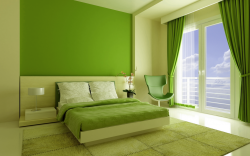 The main disadvantages of painting walls are:
The main disadvantages of painting walls are:
- the need for careful preparation of the walls so that the result is truly appropriate;
- at first glance, painting walls is a mere trifle, but, in fact, an ideal surface is obtained only with appropriate surface preparation;
- many still believe that painting in one color is boring and definitely not suitable for home, but this can be argued, because everyone has different tastes, and no one bothers to paint one wall in a different color;
- paints, although resistant to mechanical stress, can not withstand a more or less severe impact on the surface;
- almost all paints, except glossy, are able to absorb dust from the air.
Choose paint
General advantages and disadvantages are typical for all types of paints, but they are distinguished by several basic types, and each has its own characteristics and characteristics. Paints are divided into groups according to a film-forming base.
Alkyd paints
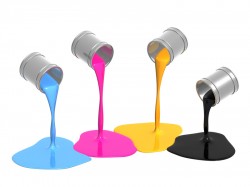 Alkyd paints have good moisture resistance and resistance to UV rays. In this group, oil and enamel paints are isolated. Oil paints are inexpensive, but dry for a very long time, while emitting an unpleasant toxic odor, and can turn yellow over time, so it is better not to use them for painting internal surfaces. In addition, it does not allow air to pass through well, so after some time cracks are visible on the surface.
Alkyd paints have good moisture resistance and resistance to UV rays. In this group, oil and enamel paints are isolated. Oil paints are inexpensive, but dry for a very long time, while emitting an unpleasant toxic odor, and can turn yellow over time, so it is better not to use them for painting internal surfaces. In addition, it does not allow air to pass through well, so after some time cracks are visible on the surface.
Enamel paints manifest themselves much better: they dry quickly, do not emit a smell, are suitable for a huge type of surface, have anti-corrosion properties, are light and waterproof.
Emulsion paints
In water-based paints, coloring pigments are dissolved in water, and when it dries, an even, uniform coating remains on the wall.They are easy to use, environmentally friendly, odorless, they can be washed, after applying paint it is easy to wash the tool from it and reuse it. You can apply them on almost any surface, only it is better to prime the metal elements beforehand, and it is better not to use a water-based emulsion paint on top of glossy and adhesive paints, but all other types of paints are well laid on its base.
Among acrylic paints distinguish the following types:
- water based paints They breathe well, do not exfoliate, they amaze with a variety of colors, and variants that give a three-dimensional structure may also occur. However, they can not be used in rooms with high humidity, and from frequent washing they can be erased a little. However, this is one of the most popular and used paints for interior work;
- water dispersion they also conduct air and steam well, but they can be washed many times, they do not exfoliate and show good results in operation. But they, as a rule, are presented only in white, and applying them at temperatures below +5 degrees is difficult;
- acrylic paints very strong, flexible, have high mechanical resistance, as well as high gas impermeability. The last property makes it possible to color reinforced concreteto protect it from corrosion, but acrylic paint is not suitable for fresh plaster, since carbon dioxide is released during hardening, and it is gas-tight. Such paint can be tinted, it does not fade in the sun over time, can hide even small cracks, has vapor-permeable and water-repellent properties. True, they are expensive, since acrylic resins are used as the basis;
 latex paints They show excellent water resistance, so you can wash them as much as you want without losing the quality of the coating. It may fade slightly under the influence of ultraviolet rays. The paint is perfect for all types of surfaces, dries quickly, but of the emulsion it is the most expensive;
latex paints They show excellent water resistance, so you can wash them as much as you want without losing the quality of the coating. It may fade slightly under the influence of ultraviolet rays. The paint is perfect for all types of surfaces, dries quickly, but of the emulsion it is the most expensive;- polyvinyl acetate paints - a cheaper option, they do not fade in the sun, are environmentally friendly, resistant to oils and fats, but are washed off under the influence of water;
- silicone paints after drying, they form a layer of paint that is resistant to the action of water, but perfectly vapor and air permeable, they can hide cracks up to 2 mm, and are applicable to any mineral surfaces, can be applied on top of some paints, but the rather high price does not contribute to their widespread distribution .
Adhesive paints
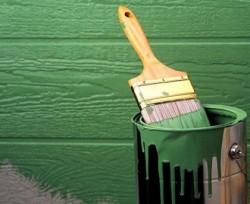 Glue paints consist of organic polymers based on water, have properties similar to emulsion paints, but are more afraid of water, therefore they are used only in rooms where its effect is limited. So, in damp and poorly ventilated rooms, such paint can become a habitat for microbes and bacteria.
Glue paints consist of organic polymers based on water, have properties similar to emulsion paints, but are more afraid of water, therefore they are used only in rooms where its effect is limited. So, in damp and poorly ventilated rooms, such paint can become a habitat for microbes and bacteria.
And depending on which substances are used in the manufacture of paint, several types are distinguished:
- dextrous - on inert glue, not bad for internal work, but not in particularly wet rooms;
- casein - the most persistent and aesthetic of the presented, suitable for use on mineral bases such as brickconcrete and plaster;
- adhesive paints have a huge selection of colors, are environmentally friendly.
Silicate paint
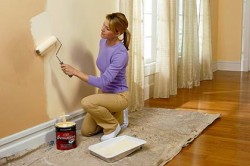 These are mineral paints, which include liquid glass, and since the paint has an alkaline reaction, then when applying it, you must be extremely careful. This composition imposes restrictions on the use: glass, metal, stone and ceramic surfaces are afraid of such an environment, so this paint is not suitable for them. You can not use it on top of alkyd acrylic paints, because of its composition, the choice of colors is also limited. But all this is compensated by the pros: the paint has excellent vapor and air permeability, can be washed, resistant to temperature extremes.
These are mineral paints, which include liquid glass, and since the paint has an alkaline reaction, then when applying it, you must be extremely careful. This composition imposes restrictions on the use: glass, metal, stone and ceramic surfaces are afraid of such an environment, so this paint is not suitable for them. You can not use it on top of alkyd acrylic paints, because of its composition, the choice of colors is also limited. But all this is compensated by the pros: the paint has excellent vapor and air permeability, can be washed, resistant to temperature extremes.
Choose color
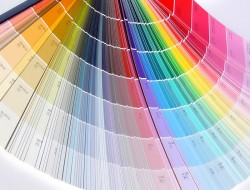 The color of painted surfaces is also important, since the entire area of the walls will now and then affect people who are constantly in the room. So, let's start with classic rule: if the room faces north and there is little light in it, then it is better to use light shades, if the room is southern and light, then you can use cold tones, and even bright colors, although they visually hide the room. Another rule follows from this: if the room is small, then light and pastel tones are great for it, which can even expand it a little visually - bright colors are suitable only for very spacious rooms or as an accent on one wall.
The color of painted surfaces is also important, since the entire area of the walls will now and then affect people who are constantly in the room. So, let's start with classic rule: if the room faces north and there is little light in it, then it is better to use light shades, if the room is southern and light, then you can use cold tones, and even bright colors, although they visually hide the room. Another rule follows from this: if the room is small, then light and pastel tones are great for it, which can even expand it a little visually - bright colors are suitable only for very spacious rooms or as an accent on one wall.
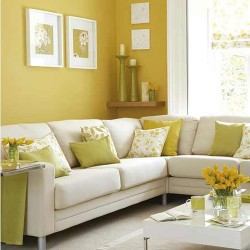
For bedroom and living room it is better to choose unobtrusive calm colors: beige, light green, light brown, peach, etc. They are also suitable for the nursery, but there you can make the game part a little brighter than the rest of the room. In cabinets, it is recommended to use shades of yellow, as psychologists have proven that it positively affects creative activity, and in kitchens - shades of red or lighter and more discreet colors, especially if the kitchen is small.
For traditionally small rooms, such as an entrance hall, a bathtub and a kitchen, it is better to choose a dull paint: light shades of orange, apricot, yellow, beige, milky brown, etc. will do. In any case, before buying the right amount of paint, you need to think carefully about the general concept of the interior: what color the furniture will be, curtains, other elements of decor, how all this will be combined, whether it will look organically, etc.
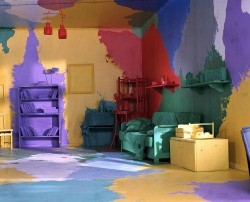 A good idea to diversify the interior would be a choice two shades of paints, but this is a rather complicated question, since you need to correctly combine not only the colors of the paints, but also choose them correctly for the interior, which is difficult even for some designers. Questions of difficulties in painting, we omit for now. So, you can choose the easiest way in this case: paint one wall in a shade that exactly differs from the rest of the walls, for example, beige walls and a light blue one wall. It can be a wall with a TV, at the head of the bed, etc., depending on which room under repair. You can create whole compositions and drawings, patterns on one wall in several colors: if the wall itself will be an accent in the interior, then you need to select paints that have a clear contrast between each other, but if the task is just interesting to design the wall, then you can combine colors that are close in the palette .
A good idea to diversify the interior would be a choice two shades of paints, but this is a rather complicated question, since you need to correctly combine not only the colors of the paints, but also choose them correctly for the interior, which is difficult even for some designers. Questions of difficulties in painting, we omit for now. So, you can choose the easiest way in this case: paint one wall in a shade that exactly differs from the rest of the walls, for example, beige walls and a light blue one wall. It can be a wall with a TV, at the head of the bed, etc., depending on which room under repair. You can create whole compositions and drawings, patterns on one wall in several colors: if the wall itself will be an accent in the interior, then you need to select paints that have a clear contrast between each other, but if the task is just interesting to design the wall, then you can combine colors that are close in the palette .
Please note that the paint in the store when they are lit looks a little different than in the room, so it makes sense to check and see if the shade suits you.
Wall painting
Necessary tools
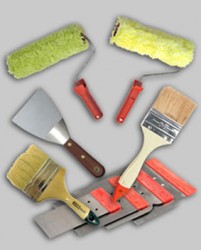 When preparing the surface you will need:
When preparing the surface you will need:
- films and newspapers for sheltering furniture and floors;
- primer and rollers for her;
- plaster or drywall for leveling the walls;
- start and finish putty;
- spatulas of different sizes;
- abrasive mesh for grinding;
- reinforcing mesh for reinforcement.
For painting:
- selected paint;
- color if necessary;
- brush and roller;
- masking tape;
- plastic tray.
Preparatory work
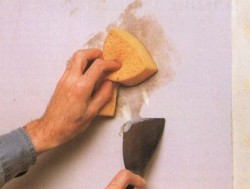 The process of applying paint is not so complicated as the preparation of the surface. If the room is undergoing global repairs, there shouldn’t be any unnecessary items there, and if you decide to only update the wall covering, you will need to evacuate all the furniture and appliances, or at least shift them to the center and cover with foil. In any case, the floor covering is covered with a film or old newspapers, lights, switches, panels, etc. are removed, and all those places that definitely should not be painted are pasted over with masking tape.
The process of applying paint is not so complicated as the preparation of the surface. If the room is undergoing global repairs, there shouldn’t be any unnecessary items there, and if you decide to only update the wall covering, you will need to evacuate all the furniture and appliances, or at least shift them to the center and cover with foil. In any case, the floor covering is covered with a film or old newspapers, lights, switches, panels, etc. are removed, and all those places that definitely should not be painted are pasted over with masking tape.
If the house is not just commissioned, and there are traces of old finishes, then you need to get rid of them.Old wallpapers are removed with a spatula, if necessary, they can be wet and slowly clean the wall. You can try to remove old paint with a spatula, but this process can give poor results, and you will need to use building hair dryer or special solutions to facilitate peeling of old paint.
The set of subsequent work depends on in what condition are the walls. If the surface is strong enough, does not have cracks, irregularities, then you can just sand the existing layer of plaster or concreteby removing a very thin top layer. Then the surface must be primed and treated with antiseptic materials, especially if there were traces of mold on it, which also peeled off.
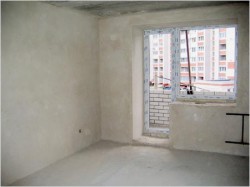
If the old plaster is obviously unsuitable for applying a new coat of paint, then it must be completely removed, even if there are some fragments where it holds well. Next, we evaluate the wall surface: if the differences are small and there are few cracks, then we apply new layer of plaster, if the walls are crooked and it makes no sense to spend so much plaster, because it also spills a pretty penny, it will be better plasterboard walls - then we get a perfectly flat surface with a fairly small amount of time.
When the walls are already leveled, they must be primed and the primer allowed to dry for at least 5-6 hours, or even more: it is better to give more time than to paint on a damp surface.
Unfortunately, the plastered surface, like the one that is covered with drywall, is not suitable for applying paint - it absorbs a lot of moisture, as a result of which all the roughness will be visible on the surface, and the color may turn out to be uneven. Therefore, it is necessary to apply starting putty layer: it should contain fine sand, which will allow it to be applied in a layer of 3-4 mm, without fear of cracking. For its application, you need a wide spatula, and for leveling and distributing the solution, a small spatula is useful. Samu putty should be prepared according to the instructions, if it involves some preparation, since there are putties that are immediately ready for use immediately after opening the container.
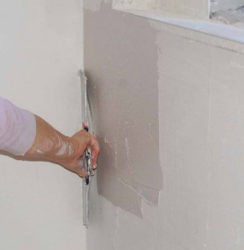
It is recommended to putty with paint using reinforcing mesh with a cell of 2 mm. First, the wall section is putty with a starting putty along the width of the grid, it is laid, pressed into the resulting layer, and then a layer of finishing putty is applied on top. At this stage, common mistakes are attempts to apply the starting putty with an ideally smooth layer, smoothing out all the transitions when the spatula moves: yes, everything needs to be smoothed out, but there is no need to overdo it - it’s better to clean the small tubercles later.
Before this grinding, it is necessary to allow the putty to dry well for 8-9 hours, and you can grind it with a coarse abrasive mesh, smoothing all performances. But even after such preparation, the walls are still not quite suitable for painting, so the turn of finishing putty comes.
Finishing putty gives the surface the necessary smoothness, as it does not have any inclusions, and also resists paint absorption. It is applied in the same way as the starting one, but here the layer thickness is already regulated at a level of 1-2 mm, otherwise there is a risk of cracking. Then the surface should also be treated with an abrasive mesh, only the grain size is already smaller - 60-80, work should be done carefully so that you do not remove the entire layer of plaster, but only the protruding elements and after the putty has dried. In some cases, to achieve an optimal result, it will be necessary to apply another layer of finishing putty. After grinding, all dust is removed, for example, with a vacuum cleaner and the surface is primed.
Paint application process
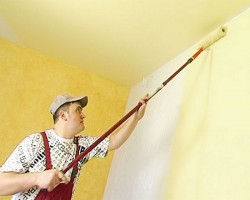 If you bought a paint of an already necessary shade, then it remains to open it, mix it, if necessary add a little water or a solvent special for the chosen type of paint, and proceed to painting.If a crust forms on the paint can, then it is better to remove it, and not mix with all the other material, in order to avoid pieces of dried paint on the wall. Water-based paint, for example, can be tinted both independently and in a store. Specialists use special computer programs that allow you to accurately calculate the number of colors that need to be added, so that in the end the color of the walls turns out exactly the way you need. But you can do everything yourself.
If you bought a paint of an already necessary shade, then it remains to open it, mix it, if necessary add a little water or a solvent special for the chosen type of paint, and proceed to painting.If a crust forms on the paint can, then it is better to remove it, and not mix with all the other material, in order to avoid pieces of dried paint on the wall. Water-based paint, for example, can be tinted both independently and in a store. Specialists use special computer programs that allow you to accurately calculate the number of colors that need to be added, so that in the end the color of the walls turns out exactly the way you need. But you can do everything yourself.
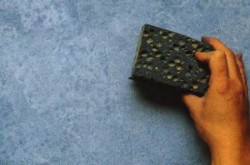 Naturally, it is better to prepare the required amount of paint immediately, otherwise there may be slight differences in shade, but, in extreme cases, you need to at least prepare paint for one wall, and the differences in shade on different walls can be attributed to the nuances of lighting, even if someone it will notice.
Naturally, it is better to prepare the required amount of paint immediately, otherwise there may be slight differences in shade, but, in extreme cases, you need to at least prepare paint for one wall, and the differences in shade on different walls can be attributed to the nuances of lighting, even if someone it will notice.
In order to apply paint, use a brush and a roller. Start from the most difficult places: joints with other surfaces (perimeter of walls), borders with windows, doors, sockets, switches, etc. For these meths, it is better to use a brush, so that later on with a roller, do not stain and paint over those places that do not need to be painted. A brush is applied with a brush 10-15 cm wide. Then they begin to work with a roller - a soft roller with a medium-length pile is optimal. Before painting, it is necessary that it is completely covered in paint, so dip it in the prepared plastic tray and roll it on cardboard or plywood so that the entire pile is in the paint, and then you can start applying to the walls.
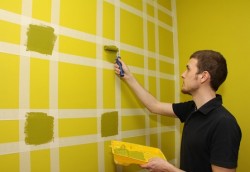 It is better to start from the wall by the window, but, in principle, this is not necessary. The main thing is that it is better to start painting the wall from top to bottom so that there are no streaks, remembering that it is better to apply several thin layers than one thick one. Two layers can be applied in mutually perpendicular directions, or each layer can be smeared in the vertical and horizontal directions, but this will require more dexterity or the use of an assistant.
It is better to start from the wall by the window, but, in principle, this is not necessary. The main thing is that it is better to start painting the wall from top to bottom so that there are no streaks, remembering that it is better to apply several thin layers than one thick one. Two layers can be applied in mutually perpendicular directions, or each layer can be smeared in the vertical and horizontal directions, but this will require more dexterity or the use of an assistant.
All subsequent layers are best applied after the previous one has completely dried - so the surface will turn out to be the most aesthetic. If desired, you can get a textured surface: for this you need a thicker solution of paint and a roller with a pattern defined by an unusual surface. It is possible to create some kind of relief even with a sponge, but this is not an amateur, therefore, if such a complicated process of leveling the walls was undertaken, many people prefer to emphasize all this with perfectly even painting.
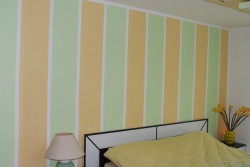
If desired combine several colors, it is better to use the same water-based paint. First, you need to draw the lines of the future drawing with a pencil on the wall, and then paint the necessary elements with lighter paint along the prepared lines, trying not to go into them for more than 2 cm. After the paint has dried, the masking tape is glued along the line and the remaining surfaces are painted, etc. with more than two colors. When the layers dry, you can peel off the tape.

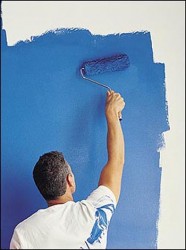
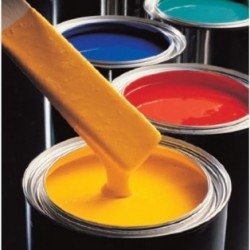 latex paints They show excellent water resistance, so you can wash them as much as you want without losing the quality of the coating. It may fade slightly under the influence of ultraviolet rays. The paint is perfect for all types of surfaces, dries quickly, but of the emulsion it is the most expensive;
latex paints They show excellent water resistance, so you can wash them as much as you want without losing the quality of the coating. It may fade slightly under the influence of ultraviolet rays. The paint is perfect for all types of surfaces, dries quickly, but of the emulsion it is the most expensive;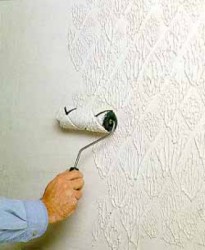
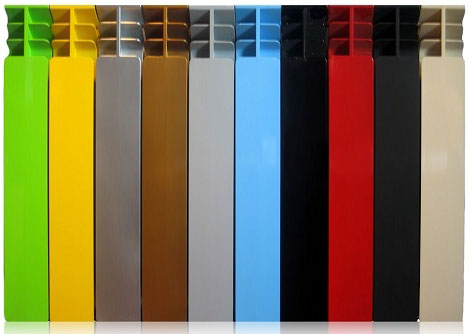



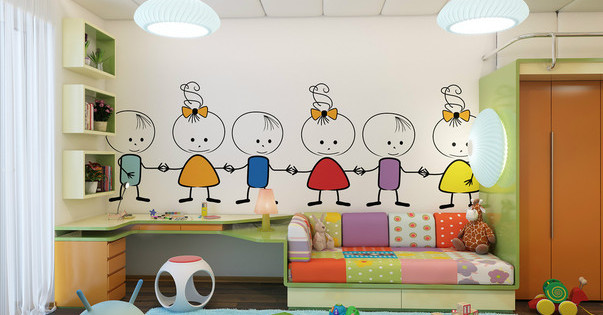
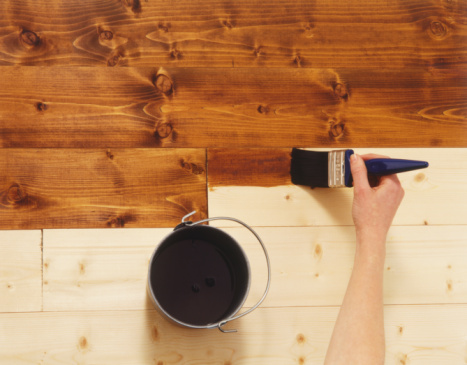

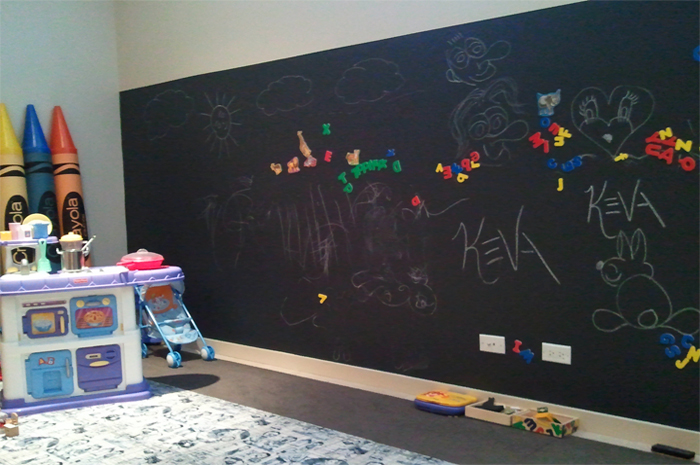


Preparation for painting walls with your own hands of wooden walls is done a little differently. For them, you can not use different versions of plaster or putty; you just need to properly polish the surfaces, clean out the dust and some excess wood after work. If you find any recesses or scratches on the wooden wall, fill them with a specialized grout.In most cases, it will have to be used to work with plank versions of the walls, since they differ in traces formed by protruding knots. Having performed the necessary treatment, the wooden surface must be treated with protective compounds and stains.